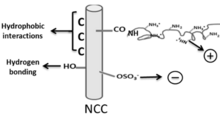Background
This technology relates to a novel carrier that can deliver active molecules such as pharmaceutical, cosmetic or agriculturally useful compounds in a controlled, non-toxic and safe manner. The carrier is composed of nanocrystalline cellulose (NCC) which has been modified with chitosan oligosaccharide (CSOS) to provide the desired material (NCC-CSOS) that can be used to encapsulate desired materials.
Description of the invention
The NCC-CSOSis prepared by first selectively oxidizing the alcohol moieties of NCC to carboxylic acid or aldehyde groups with a suitable oxidizing agent. This is then followed by chemically coupling CSOSto the oxidized NCC through amide or imine bond formation.
Early drug release studies using two cationic model drugs, namely procaine hydrochloride and imipramine hydrochloride, were loaded onto NCC-CSOS showed good binding efficiency, drug loading and release characteristics. An effective antioxidant system has also been developed by forming a complex between vitamin C and NCC-CSOS which has also proven effective. It was also shown to increase the stability of vitamin C since the NCC particles reduced the oxidation-induced degradation by acting as a barrier for oxygen to the encapsulated vitamin C in the complex.
Advantages
The NCC-CSOSdelivery carrier has the advantage of increased stability over similar systems. It can be used to deliver a wide range of chemical compounds through interactions that are hydrophobic, cationic or anionic. It can also form hydrogen bonds with many compounds. Due to the nature of the carrier material, it can be used in many formats including a liquid suspension or prepared as a thin film.
Cellulose fiber and chitosan are the first and second most abundant biopolymers in nature. They are non-toxic, biocompatible and biodegradable materials that are readily available, renewable and green alternatives to petroleum-based products. NCC has a large surface area which allows for high payloads and optimal control of dosage. Chitosan has antimicrobial, haemostatic, wound healing and mucoadhesive properties. This system combines the properties of both NCC and chitosan into one carrier.
Potential applications
As a delivery carrier for pharmaceutical, cosmetic, or agricultural active compounds could have potential applications in:
Drug delivery – in particular buccal drug delivery
Wound healing
Addressing oral cavity problems
Pesticide/herbicide delivery
Aquaculture
Cosmeceuticals

Reference
7424
Inventor(s)
Dr. Michael Tam
Seyedeh Parinaz Akhlaghi
Richard Berry
Patent status
US patent 10,307,486
CA patent 2,088,0555
Stage of development
Prototype
Contact
Scott Inwood
Director of Commercialization
Waterloo Commercialization Office
519-888-4567, ext. 43728